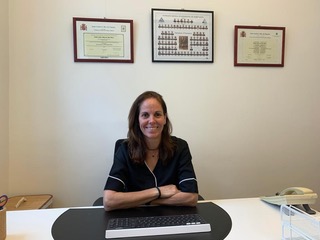Person Interviewed: Esther Ruiz de Oña
Position: Physiotherapist/Osteopath
Email: esther@estheopatia.com
Website: doctena.lu/doctor/Esther Ruiz De Oña

Briefly describe your career path.
I grew up in the world of elite sports, specifically in tennis. A serious knee injury and its subsequent recovery sparked my interest and made me realise the importance of injury treatment, prevention, and ongoing care for the human body.
From that moment on, I decided to study Physical Activity and Sports Sciences. I later completed my skills with a degree in Physiotherapy.
After my studies, I continued working in elite tennis for many years planning physical preparation, prevention and injury recovery for high-level professional players (WTA – top 10).
After that great experience in the professional circuit, I understood that the holistic approach and the integration of all its systems were key to helping the body and reaching the root of the problem, instead of treating symptoms. For this reason, I decided to do the additional Osteopathy training, that enriched me with a broader, more global and comprehensive vision. Now, I count with more than twenty years of professional experience in various practices in Madrid, Barcelona and Luxembourg.
How is physiotherapy different from osteopathy?
The difference between physiotherapy and osteopathy is based on the fact that physiotherapy directly addresses the symptoms and the pain, resulting in a more specified treatment on the affected area. On the other hand, osteopathy tries to understand the body´s behaviour from a holistic perspective, looking for the cause of the dysfunction in the body. I found that the key is to interlink all the systems; not only the musculoskeletal, but also the nervous, digestive, respiratory, vascular, endocrine and immune systems.
What are the benefits of osteopathy? What types of injuries and pathologies does it treat most frequently?
The benefits of osteopathy are vast. It can help a wide variety of dysfunctions, but also pathologies that are already established. The most frequent pathologies are disc problems such as profusions, hernias, vertebral impingement, etc.
The most commonly affected areas are the lumbar and cervical. However, more and more problems related to the imbalance of the central nervous system are seen, like headaches, migraines, insomnia, concentration problems, chronic fatigue, stress, etc.
Another typical and increasingly frequent problem is the global postural imbalance of the whole body. This imbalance generates so-called “compensation zones” by creating a distinct pain in a specific area. This imbalance can create restricted areas that affect the breathing or good digestion, for example.
What is your working method and how do you decide which treatment to use with each patient?
My working method encompasses several different approaches which are complementary at the same time.
First, I examine the patient´s body by weighing him/her on two scales to understand how his/her centre of gravity behaves, and if there is a greater displacement to one side. This provides me with a lot of information about which areas are blocked and in need of treatment.
For this treatment, the techniques are very varied. It can include joint mobility techniques, techniques to relax the soft tissue (muscle, ligament, tendon, fascia, etc.), or more direct techniques such as vertebral adjustments.
Additionally, I consider it essential to go beyond the physical body to value the fluid body. This work is much more perceptive and intuitive. The techniques are softer and more subtle. With them, we try to evaluate the internal fluids of the body and perceive the areas of greatest density to restore their mobility.
Therefore, depending on the injury or pathology of the patient, more work is done with one approach or another.
You have recently started your own cabinet in Luxembourg. What should we take into account when we look for or need a professional in these specialties?
Today, more and more people are consulting a physical therapist or osteopath for various reasons. The most common reason is acute or chronic pain that makes it impossible for them to continue with their daily activities.
Similarly, over time each of us has learned to observe our body and notice misalignments or imbalances that cause us discomfort in our posture. These types of problems are increasingly being consulted with the aim of preventing pain in the future.
Finally, we must not forget symptoms such as fatigue and insomnia that affect our day-to-day life and that are also becoming a more frequent reason for consultation.
How important is empathy in treating patients?
This question is a very interesting and accurate one.
Personally, and considering my years of experience, it is essential to establish a positive relationship with the patient. This empathic relationship begins with the first contact with the patient.
In technical terms, we call it the “Relational Field”. It refers to creating an environment of tranquillity in which the patient feels heard. This helps the patient to relax and feel at ease, establishing a bond of trust between the patient and the therapist.
fgjghjfghj

